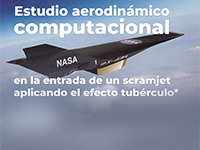Aerodynamic Computer Study on the Entry of a Scramjet Using the Tubercle Effect
DOI:
https://doi.org/10.18667/cienciaypoderaereo.640Keywords:
Aerospace Propulsion Systems, Biomimetic, Supersonic Aerodynamics, Scramjet, Tubercle EffectAbstract
This paper is based on the implementation of biomimetics, specifically the Tubercle Effect that usually occurs in the leading edge of the humpback whale’s (Megaptera novaeangliae) fins, allowing it to increase its thrust by funneling the flow. These characteristics are therefore analyzed in the Brazilian hypersonic vehicle (VHA 14-X-B), which is an experimental aircraft that operates at speeds over MACH 7, and atmosphere conditions of 30 km of altitude, powered by a scramjet. In order to increase the performance properties of the AHV (Aerospace Hypersonic Vehicle), we verify the feasibility of implementing the tubercle effect in its intake device (compression stage). The study analyzes the aerothermodynamics of the machine, using computer simulation software ANSYS-FLUENT, where different tubercles configurations are proposed, with variations in geometry and in the position on the aircraft. Afterwards, the atmospheric conditions in which the AHV operates are simulated, modifying different angles of attack that the aircraft has during its operation. Results showed that there’s more efficiency in negative angles, increasing fluid properties such as pressure, density and temperature.
Downloads
References
Anderson, J. (1990). Modern compressible flow, with historical perspective (2.aEd.). New York, Hamburg: McGraw-Hill.
Anderson, J. (2006). Hypersonic and high-temperature gas dynamics (2.a Ed.). EE. UU.: AIAA Education series. https://doi.org/10.2514/4.861956
Barros, G., Alves, V., y Toro, G. (2013). Brazilian
-x B hypersonic scramjet aerospace vehicle analytic theoretical analysis at mach number 7. En 22nd International Congress of Mechanical Engineering (COBEM). Congreso realizado en Ribeirão Preto, Brasil.
Blanco, M. (2011). Biomimética: la ciencia extrae los secretos de la naturaleza para los grandes inventos. Recuperado de http://www.madrimasd.org/informacionidi/noticias/noticia. asp?id=47513
Bolzon, M., Kelso R., y Arjomandi, M. (2015). Tubercles and their applications. Journal of Aerospace Engineering, 29(1), 04015013. https://doi.org/10.1061/(ASCE)AS.1943-5525.0000491
Capistrano, P. (2015). Análise de desempenho do veículo hipersónico aeroespacial 14-X B (tesis de maestría). Programa de Ciencias y Tecnologías Espaciales, Instituto Tecnológico de Aeronáutica, Brasil.
Canter, N. (2008). Humpback whales inspire new wind turbine technology. Tribology & Lubrication Technology, 64(12), 10-11. https://doi.org/10.1016/S1350-4789(08)70524-5
Ferraz, J., Carr, R., Gao, S., Jameson, A., Lee, C., Lu, D., Wienkers, A., y Yuan, C. (2014). Investigation of the effect of tubercles on airfoil performance. Recuperado de https://pdfs.semanticscholar.org/08ac/64172a3dfc570fdc-25f4d5efb5ab2f8bfba7.pdf
Ferrer, J. (2010). Conceptos básicos de la metodología de la investigación, tipos de investigación y diseño de investigación. Recuperado de http://metodologia02.blogspot.com/p/operacionalizacion-de-variables.html
Fish, F., y Battle, J. (1995). Hidrodynamic design of the humpback whale flipper. Journal of Morphology, 225(1), 51-60. https://doi.org/10.1002/jmor.1052250105
Fish, F., Howle, L., y Murray, M. (2008). Hydrodynamic flow control in marine mammals. Integrative and Comparative Biology, 48(6), 788-800. https://doi.org/10.1093/icb/icn029
Fish, F., Weber, P., Murray, M., y Howle, L. (2011). The tubercles on humpback whales' flippers: application of bioinspired technology. Integrative and Comparative Biology, 51(1), 203-213. https://doi.org/10.1093/icb/icr016
Fontan, M., Pinheiro, R., y Antoniazzi, M. (2015, 11 de junio). A numerical analysis of boundary-layer/ shock wave interactions in the compression ramps of scramjet intakes. En 23rd International Congress of Mechanical Engineering. Congreso realizado en Río de Janeiro, Brasil.
Martos, J., Laiton, S., Lima, B., Costa, F., y Toro, P. (2016). Investigación experimental del vehículo aeroespacial brasilero 14-X B. En IV Congreso Argentino de Ingeniería Aeronáutica. Encuentro realizado en el Instituto Universitario Aeronáutico, Córdoba, Argentina.
Misklosovic, D., y Murray, M. (2004). Leading edge tubercles, delay stall on humpback whale flipper. Physics of fluids, 16(5), L39-L42. https://doi.org/10.1063/1.1688341
Pachon, S. (2017). Análisis teórico de la entrada
de aire del Vehículo 14-X B en condiciones de ángulo de ataque. En IV Congreso Argentino de Ingeniería Aeronáutica. Encuentro realizado en el Instituto Universitario Aeronáutico, Córdoba, Argentina.
Palacios R., BF Ng y TH New. (2016). Effects of leading-edge tubercles on wing flutter speeds. Bioinspiration & biomimetics, 11(3), 036003. https://doi.org/10.1088/1748-3190/11/3/036003
Rocha, E., Rodríguez, J., Martínez, E., y López, J. (2012). Biomimética: innovación sustentable inspirada por la naturaleza. Investigación y Ciencia, 20(55), 56-61.
Sarfati, J. (2008). By design. Georgia: Creation Book Publishers
Toro, P., Carneiro, R., Araújo J., da Silva, W., Santos, M., Borba, G., Martos, J., y da Silveira, R. (2018, noviembre). Design and analysis of a generic scramjet air inlet. En 17th Brazilian Congress of Thermal Sciences and Engineering. Congreso realizado en Águas de Lindóia, Brazil. https://doi.org/10.26678/ABCM.ENCIT2018.CIT18-0751

Downloads
Published
Issue
Section
License
Assignment of Copyrights
Authors assign Ciencia y Poder Aéreo journal the exclusive rights (reproduction, distribution, public communication, and transformation) to exploit and commercialize their work, in whole or in part, in all the formats and modalities of present or future exploitation, in all languages, throughout the life of the work and throughout the world.
All contents published in Ciencia y Poder Aéreo journal are licensed under a Creative Commons Attribution 4.0 International License, whose complete information is available at http://creativecommons.org/licenses/by/4.0/
Under the terms of this license, users are free to download, print, extract, archive, distribute and publicly communicate the content of articles, provided that proper credit is granted to authors and Ciencia y Poder Aéreo, scientific journal of the Graduate School of the Colombian Air Force. Except when otherwise indicated, this site and its contents are licensed under a Creative Commons Attribution 4.0 International License.
For other uses not considered under this license it is required to contact the Director or the Editor of the journal at the e-mail address cienciaypoderaereo1@gmail.com.
The Graduate School of the Colombian Air Force and this publication are not responsible for the concepts expressed in the articles, including the metadata or the affiliation stated by authors. This is the full responsibility of the authors.





















